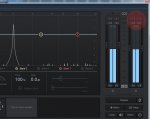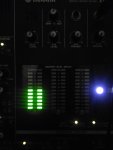Hi everyone,
I have been trying to find information on mixing, especially reading levels on a firewire connected analog mixer. In my case I use NI maschine, Cubase to sequence, with Yamaha n12 taking in all the instruments. I was wondering how do firewire mixers and their meters work? For e.g, when an instrument is recorded in Cubase via firewire with gain on the mixer till 0db, the Cubase meter also shows 0db (post recording or even while monitoring an instrument through cubase while recording). How does a dbfs meter of cubase show the same value as an analog signal was showing before recording?
What confuses me is when I set the instrument gain on the mixer to show 0dbu on the meter (before recording), the software also shows 0db after recording. How is that possible that a meter before A to D( analog meter) and a meter after A to D (digital meter) shows the same values and vice versa? Is it that I should pull the fader down on the daw track to -18dbfs after recording (A to D)?
I am clear till getting an instrument into the mixer, getting a hot signal upto 0db. But after recording when it goes in the digital domain, and playing it back through the mixer(i/o), what scale is the meter showing now? dbu or dbfs? Did D to A happen before the meter? or no D to A happen up until audio goes out to the speakers?
Or if we are working entirely in the digital domain just with a sampler, here is a straight forward question -
If i see my instrument/sample level reaching 0db, should I pull down the level first to -18db by default for headroom and just assume that since a software is always digital, everything is dbfs in this domain, like a lesson in audio? And then get my mixes upto -12dbfs with processing etc? If yes, then which fader be pulled down to -18dbfs? the instrument or the master fader?
Here are the meters when i sent a 1khz sine wave at -18dbfs from cubase to n12.


Any help will be appreciated. Thank you!
I have been trying to find information on mixing, especially reading levels on a firewire connected analog mixer. In my case I use NI maschine, Cubase to sequence, with Yamaha n12 taking in all the instruments. I was wondering how do firewire mixers and their meters work? For e.g, when an instrument is recorded in Cubase via firewire with gain on the mixer till 0db, the Cubase meter also shows 0db (post recording or even while monitoring an instrument through cubase while recording). How does a dbfs meter of cubase show the same value as an analog signal was showing before recording?
What confuses me is when I set the instrument gain on the mixer to show 0dbu on the meter (before recording), the software also shows 0db after recording. How is that possible that a meter before A to D( analog meter) and a meter after A to D (digital meter) shows the same values and vice versa? Is it that I should pull the fader down on the daw track to -18dbfs after recording (A to D)?
I am clear till getting an instrument into the mixer, getting a hot signal upto 0db. But after recording when it goes in the digital domain, and playing it back through the mixer(i/o), what scale is the meter showing now? dbu or dbfs? Did D to A happen before the meter? or no D to A happen up until audio goes out to the speakers?
Or if we are working entirely in the digital domain just with a sampler, here is a straight forward question -
If i see my instrument/sample level reaching 0db, should I pull down the level first to -18db by default for headroom and just assume that since a software is always digital, everything is dbfs in this domain, like a lesson in audio? And then get my mixes upto -12dbfs with processing etc? If yes, then which fader be pulled down to -18dbfs? the instrument or the master fader?
Here are the meters when i sent a 1khz sine wave at -18dbfs from cubase to n12.


Any help will be appreciated. Thank you!
Last edited:


